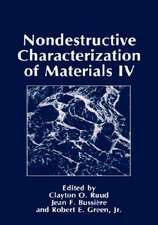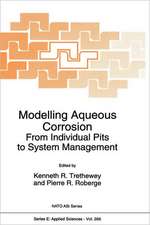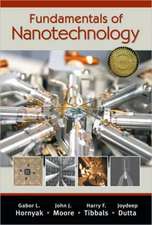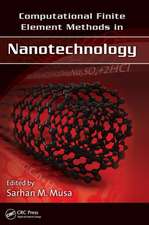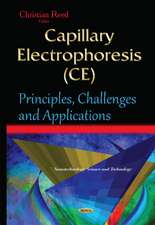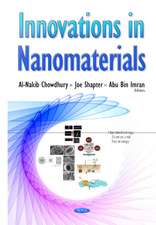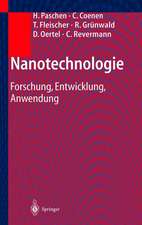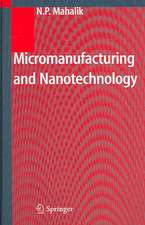Periodic Nanostructures: Developments in Fullerene Science, cartea 7
Autor Mircea V. Diudea, Csaba L. Nagyen Limba Engleză Paperback – 17 noi 2010
The authors explore foam-like carbon structures, which relate to ‘schwarzites’, and which represent infinite periodic minimal surfaces of negative curvature. They show that these structures contain polygons (with dimensions larger than hexagons w.r.t. to graphite) that induce this negative curvature. The units of these structures appear as nanotube junctions (produced via an electron beam) that have wide potential molecular electronics applications. Self-assembled supramolecular structures (of various tessellation) and diamond architectures are also proposed. The authors propose that the periodicity of close repeat units of such structures is most evident not only in these formations but also present in all of the carbon allotropes. It is also shown that depending on the lattice tessellation, heteroatom type, and/or doping, metal nanostructures (nanotubes in particular) can display both metallic and semiconductor characteristics. Therefore, their properties can be manipulated by chemical functionalization. The authors therefore suggest that nanostructures have heralded a new generation of nanoscale biological, chemical, and physical devices.
The text also provides literature and data on the field of nanostructure periodicity and the authors’ own results on nanostructure building and energy calculations as well as topological characterization by means of counting polynomials of periodic nanostructures. The aromaticity of various coverings of graphitic structures is also discussed.
This book is aimed at scientists working in the field ofnanoscience and nanotechnology, Ph.D. and MSc. degree students, and others interested in the amazing nanoarchitectures that could inspire the cities of the future.
| Toate formatele și edițiile | Preț | Express |
|---|---|---|
| Paperback (1) | 636.80 lei 6-8 săpt. | |
| SPRINGER NETHERLANDS – 17 noi 2010 | 636.80 lei 6-8 săpt. | |
| Hardback (1) | 643.34 lei 6-8 săpt. | |
| SPRINGER NETHERLANDS – 31 iul 2007 | 643.34 lei 6-8 săpt. |
Preț: 636.80 lei
Preț vechi: 749.19 lei
-15% Nou
Puncte Express: 955
Preț estimativ în valută:
121.88€ • 125.61$ • 102.90£
121.88€ • 125.61$ • 102.90£
Carte tipărită la comandă
Livrare economică 01-15 martie
Preluare comenzi: 021 569.72.76
Specificații
ISBN-13: 9789048175062
ISBN-10: 9048175062
Pagini: 224
Ilustrații: XI, 209 p.
Dimensiuni: 160 x 240 x 12 mm
Greutate: 0.32 kg
Ediția:Softcover reprint of hardcover 1st ed. 2007
Editura: SPRINGER NETHERLANDS
Colecția Springer
Seria Developments in Fullerene Science
Locul publicării:Dordrecht, Netherlands
ISBN-10: 9048175062
Pagini: 224
Ilustrații: XI, 209 p.
Dimensiuni: 160 x 240 x 12 mm
Greutate: 0.32 kg
Ediția:Softcover reprint of hardcover 1st ed. 2007
Editura: SPRINGER NETHERLANDS
Colecția Springer
Seria Developments in Fullerene Science
Locul publicării:Dordrecht, Netherlands
Public țintă
ResearchCuprins
Periodic Fullerenes by Coalescence Reactions.- Polyhex Tori.- New Classes of Toroidal Structures.- Counting Polynomials of Nanostructures.- Operations on Maps.- Aromaticity of Nanostructures.- Triply Periodic Nanostructures.
Textul de pe ultima copertă
In Periodic Nanostructures, the authors demonstrate that structural periodicity in various nanostructures has been proven experimentally. The text covers the coalescence reactions, studied by electronic microscopy, and shows that the nanoworld is continuous, giving rise to zero- (fullerenes), one- (tubules), two-(graphite) and three-(diamond, spongy carbon) dimensional carbon allotropes.
The authors explore foam-like carbon structures, which relate to ‘schwarzites’, and which represent infinite periodic minimal surfaces of negative curvature. They show that these structures contain polygons (with dimensions larger than hexagons w.r.t. to graphite) that induce this negative curvature. The units of these structures appear as nanotube junctions (produced via an electron beam) that have wide potential molecular electronics applications. Self-assembled supramolecular structures (of various tessellation) and diamond architectures are also proposed. The authors propose that the periodicity of close repeat units of such structures is most evident not only in these formations but also present in all of the carbon allotropes. It is also shown that depending on the lattice tessellation, heteroatom type, and/or doping, metal nanostructures (nanotubes in particular) can display both metallic and semiconductor characteristics. Therefore, their properties can be manipulated by chemical functionalization. The authors therefore suggest that nanostructures have heralded a new generation of nanoscale biological, chemical, and physical devices.
The text also provides literature and data on the field of nanostructure periodicity and the authors’ own results on nanostructure building and energy calculations as well as topological characterization by means of counting polynomials of periodic nanostructures. The aromaticity of various coverings of graphitic structures is also discussed.
This book is aimed at scientistsworking in the field of nanoscience and nanotechnology, Ph.D. and MSc. degree students, and others interested in the amazing nanoarchitectures that could inspire the cities of the future.
The authors explore foam-like carbon structures, which relate to ‘schwarzites’, and which represent infinite periodic minimal surfaces of negative curvature. They show that these structures contain polygons (with dimensions larger than hexagons w.r.t. to graphite) that induce this negative curvature. The units of these structures appear as nanotube junctions (produced via an electron beam) that have wide potential molecular electronics applications. Self-assembled supramolecular structures (of various tessellation) and diamond architectures are also proposed. The authors propose that the periodicity of close repeat units of such structures is most evident not only in these formations but also present in all of the carbon allotropes. It is also shown that depending on the lattice tessellation, heteroatom type, and/or doping, metal nanostructures (nanotubes in particular) can display both metallic and semiconductor characteristics. Therefore, their properties can be manipulated by chemical functionalization. The authors therefore suggest that nanostructures have heralded a new generation of nanoscale biological, chemical, and physical devices.
The text also provides literature and data on the field of nanostructure periodicity and the authors’ own results on nanostructure building and energy calculations as well as topological characterization by means of counting polynomials of periodic nanostructures. The aromaticity of various coverings of graphitic structures is also discussed.
This book is aimed at scientistsworking in the field of nanoscience and nanotechnology, Ph.D. and MSc. degree students, and others interested in the amazing nanoarchitectures that could inspire the cities of the future.
Caracteristici
An atlas of fascinating nano-structures, which could also be used for illustrating a fiction book The solid theoretical background will ensure a good reliability of the included information Includes supplementary material: sn.pub/extras













